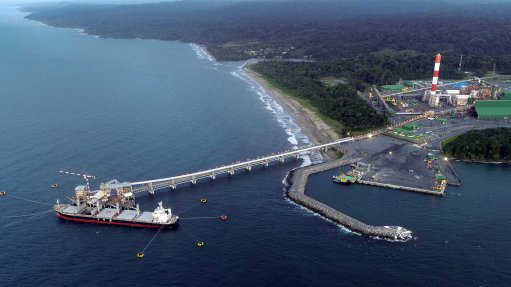Labour unrest impacts negatively on South African gold miners
The new operating model implemented in November 2012 at gold producer
Gold Field’s South Deep gold mine, 45 km southwest of Johannesburg, Gauteng, has introduced a change in shifts for mineworkers.
Although South Deep says the implementation of the new model involved consultation with two unions, the unions are, however, challenging the gold mining industry on labour relations issues pertaining to wages for mineworkers. This could affect the South African mining industry negatively.
“It took tough negotiations with the National Union for Mineworkers (NUM) and United Association of South Africa (Uasa) – including several meetings and engagements with organised labour – to reach an agreement to implement these changes. Although the engagements with the unions proved to be a challenging period, the mine is very pleased with the outcome, reached in October last year,” states South Deep VP and head of operations Ken Matthysen.
“South Deep is one of the few mechanised mines in South Africa. It is an operation with a large orebody and reserves that will enable the mine to operate for the next 50 years. “Currently, we are ramping up our operations and have been involved in several projects,” he adds.
The agreement between South Deep and the unions highlights the key aspects of the new operating model, stating that all underground operational personnel in job cate- gories A4 to C5 will be incorporated into a new four-by-four, 12-hour-rotation shift structure. Mineworkers will work for four days and have four days off and they will work for four nights and four days in rotation. Also, the operation will shut down each year for eight days, starting on December 23, translating into an effective 12-day Christmas break for each employee.
SA Labour Sector
Meanwhile, Reserve Bank governor Gill Marcus warned in May that the increasingly fraught labour relations environment and the high wage demands in the mining sector, in particular, were likely to continue to have an adverse affect on the volume of mining exports and might affect South Africa’s credit ratings.
She added that the outlook for the sector remained bleak, with threats of shaft closures and retrenchments, falling commodity prices, high wage demands and a risk of protracted periods of industrial action and further supply disruptions.
“In its eight-page list of demands, the NUM is asking for a 60% increase in entry-level wages and 15% for other job grades in gold and coal. Uasa is asking for 18% and Solidarity for 10%,” Marcus pointed out.
“South Africa’s labour relations are at a defining moment in the country’s history. Over the past few years, unprotected strike action has escalated into an uncontrolled, violent and unlawful landscape, led by a mob mentality in the absence of formal and recognised leaders,” explained Marcus.
With reports in the media suggesting that nationalisation no longer appears to be on South Africa’s policy agenda for mines, companies continue to call for government to establish clear long-term regulations. “Mining companies have decades-long investment horizons and fear arbitrary and unpre- dictable regulatory change. It is critical that they have a regulatory framework on which they can rely when making long-term investment decisions,” states Creamer Media’s Research Chan- nel Africa ‘Gold 2013’ report.
The impact of labour unrest on the gold mining industry was significant, with several gold mining companies being forced to halt operations, as a result of widespread wildcat strikes.
The ‘Gold 2013’ report notes that unions, such as the NUM, Solidarity and Uasa agreed to a new pay structure for the gold mining industry in late October 2012. The agreement was negotiated with the South African Chamber of Mines (CoM), representing gold producers AngloGold Ashanti, Gold Fields and Harmony, which agreed to an addendum to the gold sector’s 2011 to 2013 wage agreement.
In May, CoM confirmed receipt of the proposals by the NUM in respect of the review of wages and conditions of employment of gold mining companies represented by the CoM. Based on records of mineworkers who were union members at the end of March, the CoM confirmed that the NUM represented about 65.5% of employees within the relevant bargaining categories at these member mines.
Dr Elize Strydom, who leads the gold producers’ negotiating team notes that the CoM and the unions will seek to reach common ground during a particularly challenging period in the gold industry, in negotiations that are scheduled to have started in mid-June this year.
Strydom also adds that the companies would engage the unions to agree on a protocol that will guide the conduct of all parties during this time.
“Our draft protocol states that all parties will seek to achieve an early settlement that is fair to employees, the unions and the companies, and avoid a pro- tracted negotiating process, which brings uncertainty and instability for all.
“We appeal to all parties to explore every option in trying to reach a settlement without resorting to damaging industrial action and to reach agreements that will strike a balance between what is affordable to the companies and the expectations of the employees. The future of the gold industry is in our collective hands – it is our responsibility to ensure its safety and sustainability,” she points out.
Comments
Press Office
Announcements
What's On
Subscribe to improve your user experience...
Option 1 (equivalent of R125 a month):
Receive a weekly copy of Creamer Media's Engineering News & Mining Weekly magazine
(print copy for those in South Africa and e-magazine for those outside of South Africa)
Receive daily email newsletters
Access to full search results
Access archive of magazine back copies
Access to Projects in Progress
Access to ONE Research Report of your choice in PDF format
Option 2 (equivalent of R375 a month):
All benefits from Option 1
PLUS
Access to Creamer Media's Research Channel Africa for ALL Research Reports, in PDF format, on various industrial and mining sectors
including Electricity; Water; Energy Transition; Hydrogen; Roads, Rail and Ports; Coal; Gold; Platinum; Battery Metals; etc.
Already a subscriber?
Forgotten your password?
Receive weekly copy of Creamer Media's Engineering News & Mining Weekly magazine (print copy for those in South Africa and e-magazine for those outside of South Africa)
➕
Recieve daily email newsletters
➕
Access to full search results
➕
Access archive of magazine back copies
➕
Access to Projects in Progress
➕
Access to ONE Research Report of your choice in PDF format
RESEARCH CHANNEL AFRICA
R4500 (equivalent of R375 a month)
SUBSCRIBEAll benefits from Option 1
➕
Access to Creamer Media's Research Channel Africa for ALL Research Reports on various industrial and mining sectors, in PDF format, including on:
Electricity
➕
Water
➕
Energy Transition
➕
Hydrogen
➕
Roads, Rail and Ports
➕
Coal
➕
Gold
➕
Platinum
➕
Battery Metals
➕
etc.
Receive all benefits from Option 1 or Option 2 delivered to numerous people at your company
➕
Multiple User names and Passwords for simultaneous log-ins
➕
Intranet integration access to all in your organisation


















